Moselle River cruise with VIVA Cruises: A review
Have you ever taken a river cruise? As I write this, I just came back from one, operated by VIVA Cruises.
Disclosure: This is a sponsored post. VIVA Cruises provided my week-long all-inclusive cruise. Nevertheless, they have no influence over what I write. I have tried to be as unbiased in my evaluation as possible.
Another disclosure: This article contains affiliate links. If you click on one and make a purchase, I will receive a small commission. This will not affect your price.
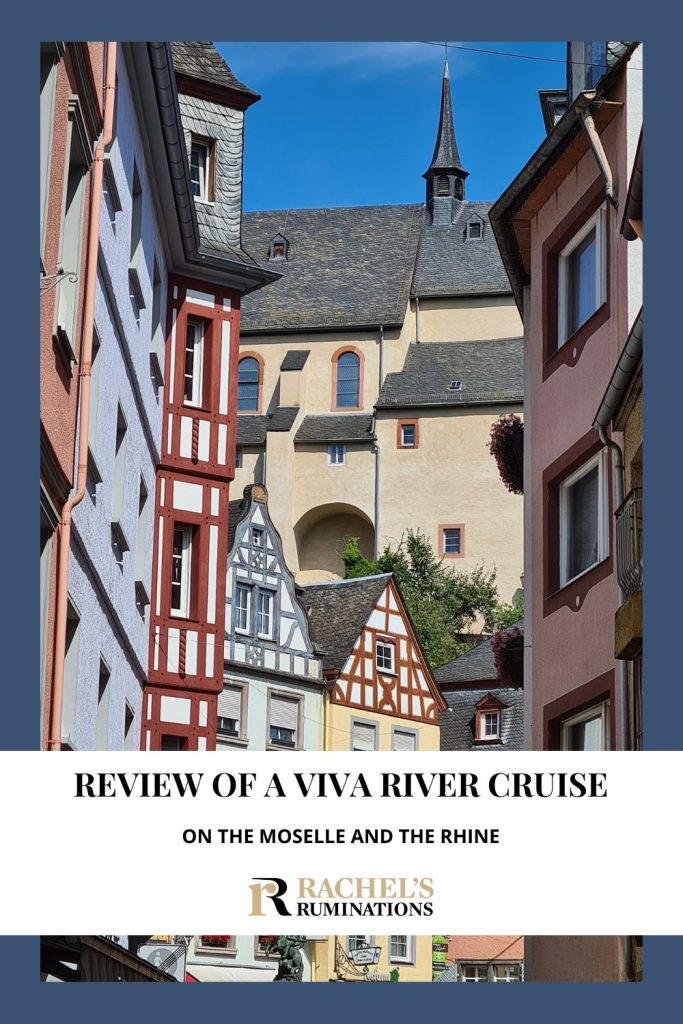
A river cruise is a whole different animal from a sea cruise like the Princess cruise I took just before this one, but that comparison is something I’ll look at in a later article. For now, I’ll just describe and review my experience on VIVA’s ship, the VIVA Moments, on its “Moselle Fairytale” route in Germany.
Use the table of contents below to skip to whatever questions you want answered.
VIVA Cruises? I’ve never heard of them!
VIVA is a fairly new cruise company, founded in 2018, but it’s part of an older company called Scylla. Interestingly, Scylla designs and builds ships themselves, selling or chartering them to other companies as well. At one point on this cruise, we moored right next to a Tauck tours ship and it was exactly the same design. Presumably Tauck either rents it or bought it from Scylla.
VIVA operates river cruises across Europe in places like Germany, the Netherlands, Austria, Hungary, France and Portugal. It shows nine ships on its website holding 52-95 cabins, accommodating 88-190 passengers. There are no “inside cabins” because of the nature of riverboats. They are limited to a height that can fit under bridges and a width and length that can fit into locks on the rivers. That means they are very long and very narrow.
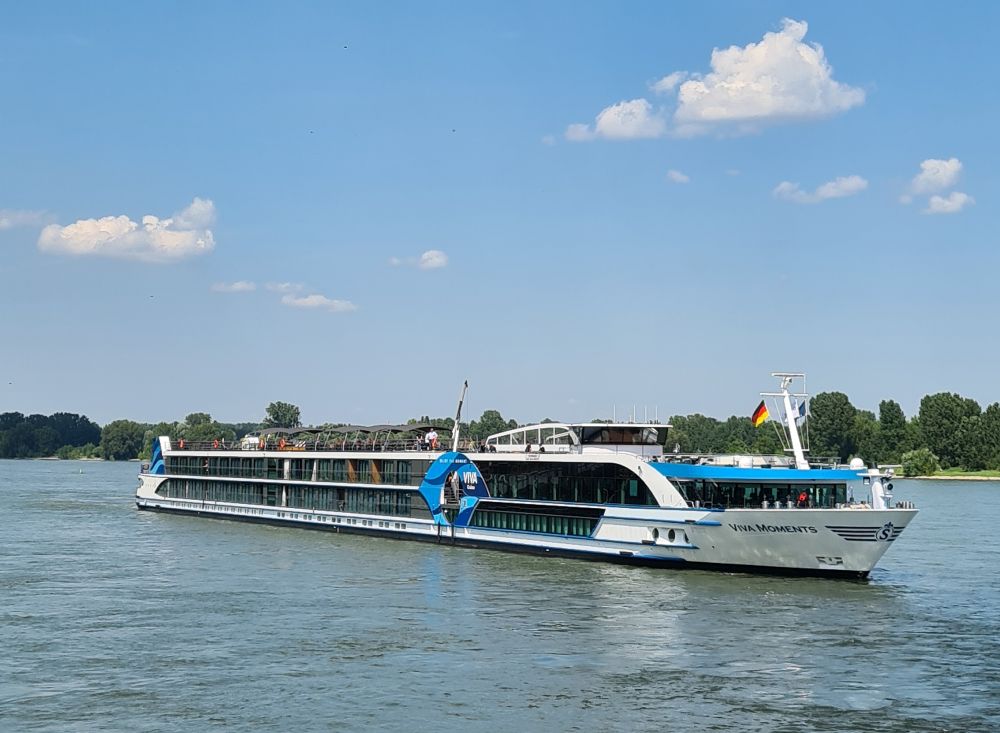
Originally only serving a German market, VIVA attracts an international clientele these days. About half their customers come from German-speaking markets and most of the rest come from other parts of Europe. Their working onboard languages are German and English, with the staff generally better in English than German. Lately they’re reaching out to English speakers more, trying to gain more guests from North America in particular. (Hence, this sponsorship.)
Until the end of 2024, you can use the code RACHEL5 to get a 5% discount when you book a Viva Cruise!
What is a VIVA ship like?
VIVA Moments is one of VIVA’s newer ships, commissioned in 2018. It’s 135 meters long (443 feet) and 11 meters wide (36 feet), which is about the limit that can fit into a lock on the Moselle River.
I’ll describe my cabin in the next section, but here I’ll describe the common spaces. Entering the ship, you walk into the lobby, with a reception desk and also a travel desk, where the cruise director works on arranging excursions and such. A central table is the place to pick up information like maps of each day’s stop. A very small store sells bags, scarves and such. There’s a coffee and tea machine as well as a place to fill water bottles.
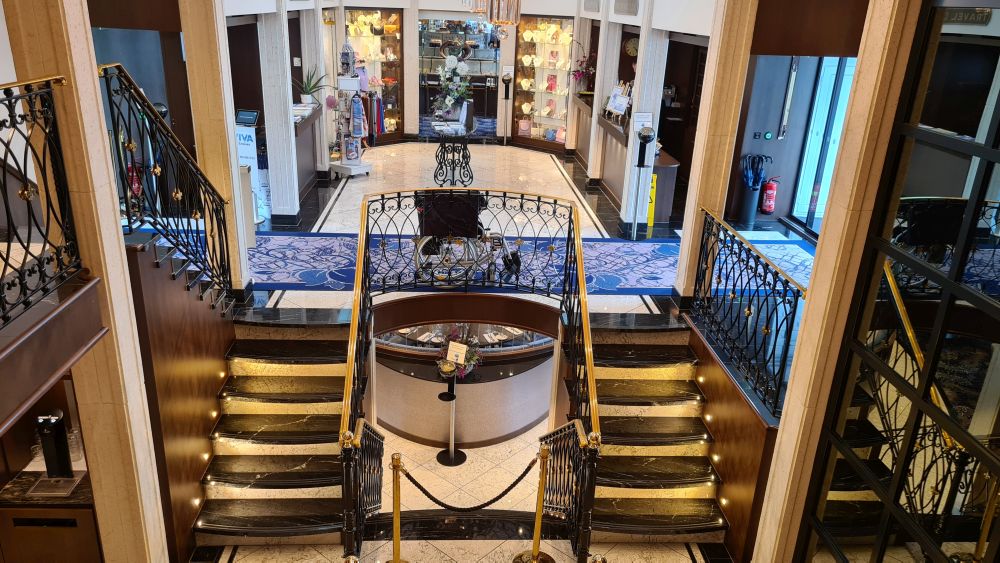
At the front of the ship is the lounge, with a bar and scattered tables, comfy chairs and sofas. Big windows let in the views on three sides. Right below the lounge and about the same size is the dining room, also with large windows.
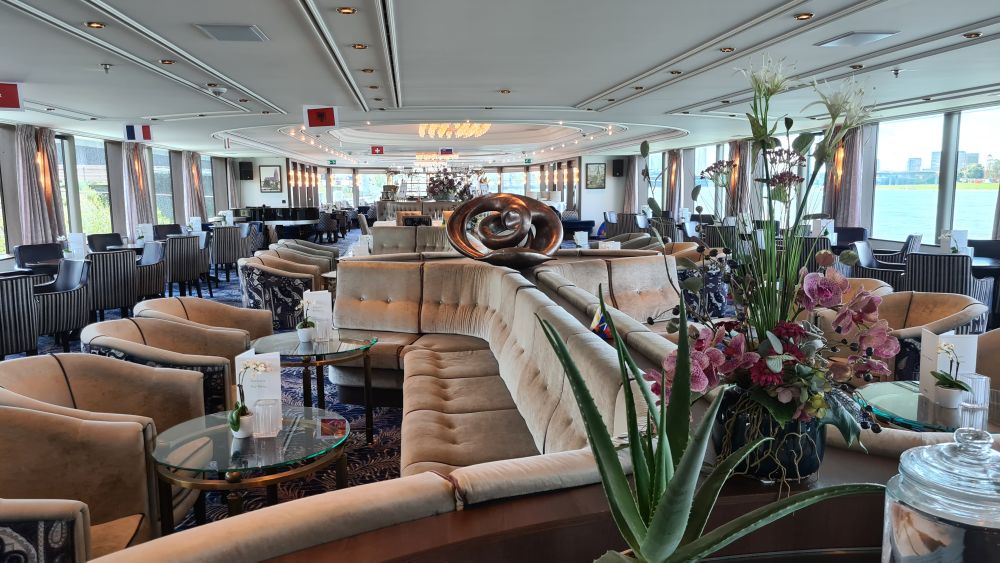
On the top deck – the roof of the boat – guests can wander the entire length of the ship, which is divided to some extent by its furnishings. One section has high glass walls to cut the wind to comfortable all-weather seating. I never used that part. It was July and the breeze felt good, but I’m sure the walls help in the spring and fall when it’s chillier.
Another section has chairs and tables and a cloth shade above it – at least when it’s not passing under a low bridge, when the shade has to be lowered. Another section has no shade and lounge chairs allow guests to soak in the sun. At the back of the sundeck is a small golf putting green and an even smaller hot tub. Its water is warm but it isn’t a jacuzzi; just a dipping pool.
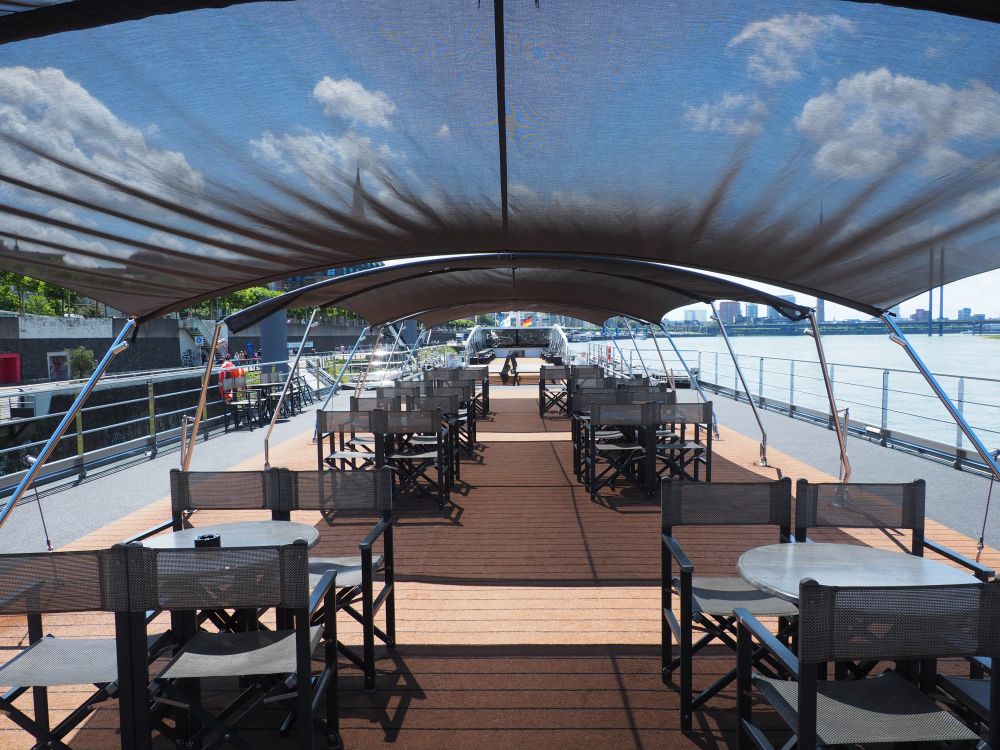
My favorite part of the sundeck was the very front, in front of the bridge. It has comfortable seating, great views ahead, and is very conveniently located in relation to the bar right below it.
Down where the lowest floor of cabins is, there’s a small gym with a row of machines for biking and such. There’s also a small hair and nail salon and a spa for massages.
The only other public space to mention is the bistro, a smaller eating venue than the dining room, situated at the very rear of the ship.
That’s it. It’s not an ocean cruise ship, so there are no activities rooms, no casino, no theater: only one bar and two restaurants.
What are the cabins like on a VIVA ship?
On three decks, the 88 cabins hold 176 passengers, plus a 48-person crew. Cabins on the top and middle deck have French balconies, while cabins on the lower deck have windows that cannot be opened. I had one on the top floor with a French balcony. It is the same size as most of the cabins on board, and there are also a handful of slightly larger suites.
I was very happy with my cabin. I was traveling solo, but I suspect that even with my husband it wouldn’t have felt too crowded. The double bed has two separate sets of bedding, one for each side. The sheets and pillows are good quality, and the mattress is comfortable. A bedside table with reading lamps and an outlet stand on each side of the bed.
Opposite the bed is a desk – sizeable enough to be a comfortable workspace – with a tv mounted above it. There are two wardrobes, one on either side of the desk, so two people’s belongings can all fit on the shelves and hangars out of sight. For me alone it was far more space than I needed.
Another cabinet holds a mini-fridge – stocked with a few soft drinks and beer, which are included in the price – that was restocked every day. It also has a small safe. Above that, on a shelf, is a coffee maker, with the necessary pods and cups and such in a drawer. Unfortunately, tea makings aren’t provided in the room, but I could walk to the lobby to fetch tea there whenever I wanted it.
Next to the window are two chairs – quite comfy – with a small table between them. All of it is tastefully done in earth tones and navy blue. The desk’s top is marble.
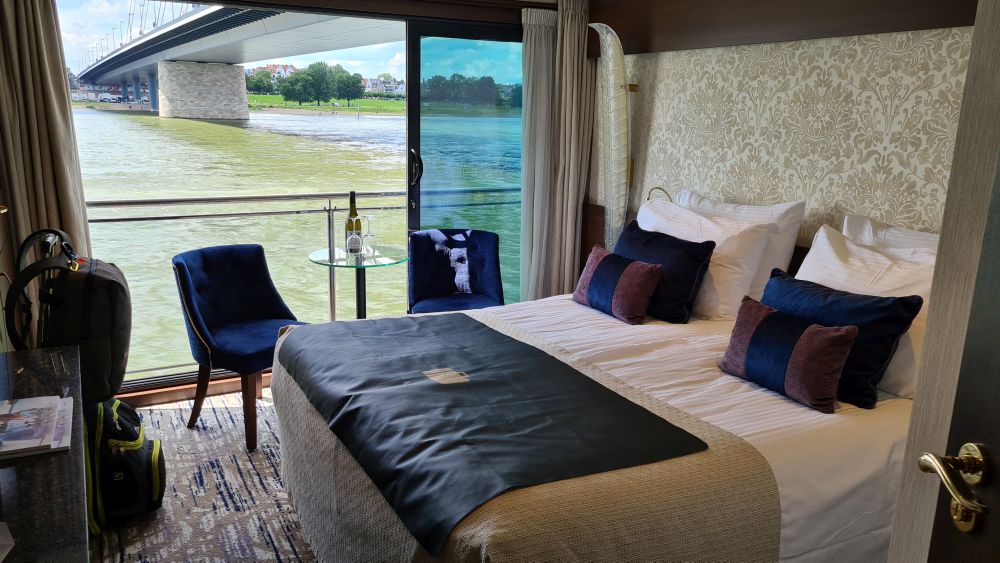
All of these items were to be expected, in my view, but two things really stood out about the room: the windows and the bathroom.
The entire outer wall of the room is fitted with three floor-to-ceiling sliders. I could slide two of the doors to one side, allowing lots of fresh air and a gorgeous unimpeded view into the cabin. See the photo above, where the sliders are fully open. It made it feel like the whole room was a balcony.
The bathroom, too, exceeded expectations. I expected a similar size to the one on the Princess cruise I took recently or the Celestyal cruise I took a couple of years ago, but this was distinctly better. It was a long rectangle with sink (marble counter), then toilet, then shower at the end. I was pleased to see that the shower was larger and had a glass door instead of a curtain. I complained at the size of the shower on the Princess cruise because I couldn’t bend down to pick up a washcloth I dropped. Here I could.
The provided shampoo, conditioner and shower gel were all Rituals brand.
Since there’s so much free time on a river cruise, I spent quite a lot of time in my room. I felt at home there. I was happy to have easy-to-reach outlets at the desk when I worked and, sitting there, I enjoyed the breeze and the view out the wide-open windows.
The room was spotlessly clean and the cleaners came in twice a day to keep it that way. They even did a turn-down service with a piece of chocolate waiting for me in the evening.
My cabin was on the right side of the ship. This was perfect on the Moselle part of the journey, since when we stopped, we tied up to the left side of the ship. I woke up each morning to another pretty view. On the other hand, it was more hit or miss on the Rhine: there are more river boats there, and sometimes mooring the boat involves being tied up parallel to another ship. In that case, the passengers on the outer boat have to pass through the inner boat to reach theirs. One morning I woke up and opened my curtains to see the windows and closed curtains (fortunately!) of another ship just a meter or two away!
How are the food and drinks on VIVA?
The VIVA Moments has two eating locations: a dining room for all meals and a “bistro” for lunch and dinner (by reservation). In the dining room, there was no set seating or set meal times, though meals are only served for about two hours each. As for drinks, there’s a bar in the lounge but drinks can also be ordered on the sun deck and in both restaurants.
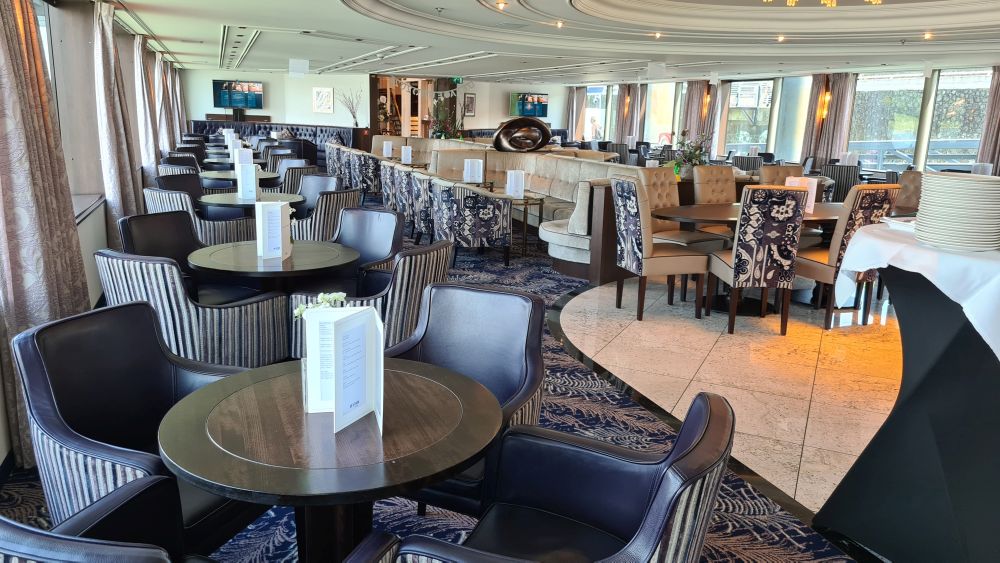
I should point out here that I was a bit unlucky on this cruise as far as the passenger list is concerned. According to the cruise director, the passengers normally come from a variety of countries, with a lot of Germans but also plenty of other Europeans and some Americans. Normally I would have had no problem finding people to chat with in English (or Dutch) so finding dinner companions wouldn’t have been a problem.
Instead, we had almost all Germans on this cruise. There was a small group of about eight Norwegians who spoke English but mostly stuck together; one American couple; and the cruise director, a Canadian.
This situation made the dining room a bit of a gamble each day. I’m fine with eating alone, but there are only a few two-person tables, and they were usually taken by couples. If they were there, I sat with the American couple. Otherwise, I would have to either take a four-person table by myself or a waiter would place me with a German couple. Most of these older German couples could speak little or no English and my German is non-existent. It made for an awkward meal.
Breakfast in the dining room
Breakfast is a pretty typical buffet-style breakfast, but there is also a menu of hot food – particularly eggs – that can be made to order. There are plenty of choices, mostly in the form of things to put on bread, but also pastries, cereal, fruit, yogurt, juices, and so on. Waiters offer coffee or tea and generally make themselves useful making sure everyone gets what they want.
Lunch and dinner in the dining room
Lunch is a hybrid of buffet and service. The appetizers, salad, desserts and cheeses are served buffet style, while guests order soups and mains from a menu. The starters, soups, main courses and desserts differ every day. There are always vegetarian options as well as pasta.
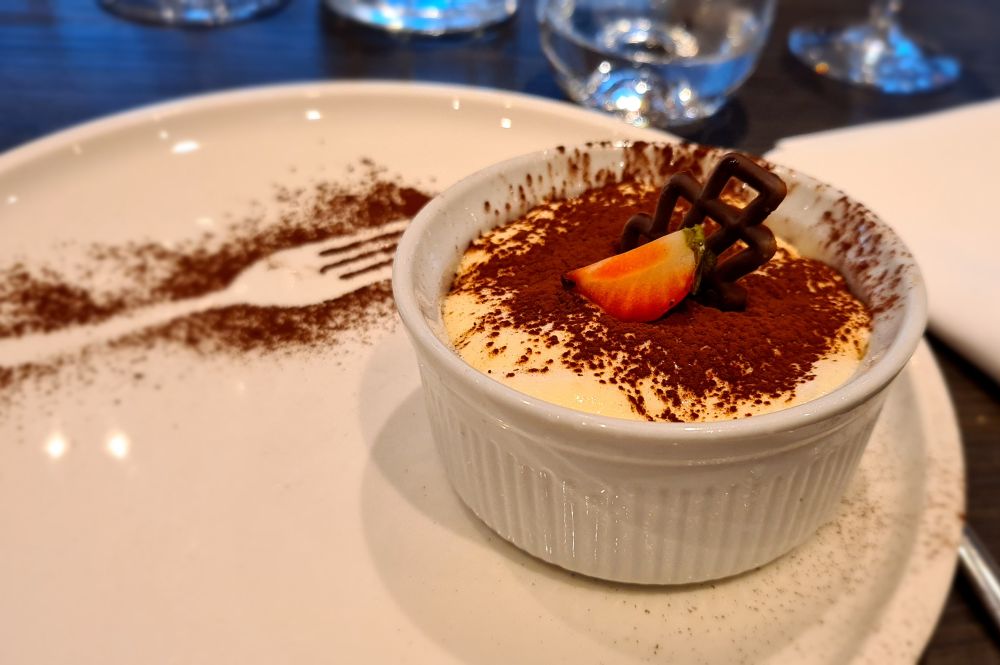
Dinner is full-service, with the waiters taking all the orders at once: starter, soup, salad, main, dessert and cheese, not that there’s any requirement to have all the courses! Fortunately the portions are small (at lunch too) so having a starter, a soup, a main course and a dessert is not too much.
And that’s good too, because the food ranges from very good to excellent. I thought the soups were particularly flavorful, and the meats are imaginatively prepared and prettily plated. The starters are wonderful, often no more than a bite or two in size and attractively presented.
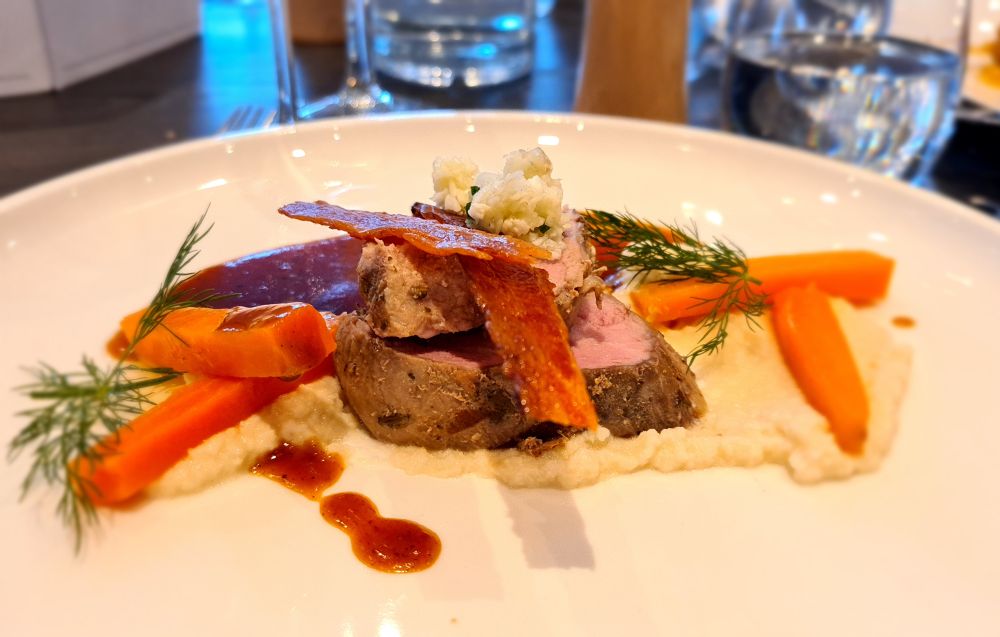
Lunch and dinner in the bistro
The bistro is small, seating about 20 people, I’d guess. At lunch it’s first come, first served, while reservations are necessary for dinner, and it does fill up. It’s distinctly quieter than the dining room, and feels more like a real restaurant.
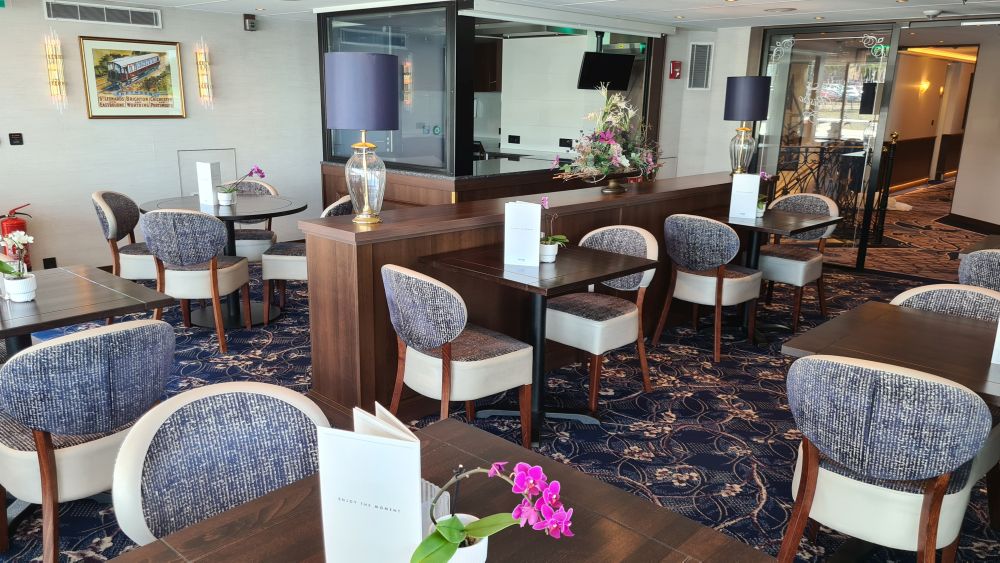
The bistro menu is the same every day, and tends to more casual than the dining room, with entrees like hamburgers – though they’re fancy hamburgers – and pulled pork. The chef is in a glassed-in space next to the seating, so, depending where you’re sitting, you can see the food being prepared.
Without a doubt the best item on this menu is the shrimp, served with a cauliflower side. It sounds plain, but whatever spices the chef uses are perfect. You might want to order a double portion. Make your reservations early in the week.
A note on the service
Here’s where the meals and bar service on the VIVA Moments really stand out. On a luxury cruise, you would expect very attentive service, and it is. There was a different atmosphere, though, than I’ve seen on the few other cruises I’ve been on. The waiters were allowed to show their personalities and interact with the passengers. They made jokes or small talk rather than just following orders and scurrying away. It made for a relaxed, casual feel that I liked.
Until the end of 2024, you can use the code RACHEL5 to get a 5% discount when you book a Viva Cruise!
Are there activities or any entertainment on VIVA cruises?
The only entertainment was a single guitarist/singer named Dany Blair, but he’ll only be on the ship for a few more weeks. He’s an excellent singer, and mostly stuck to mellow cover songs rather than his own work. You can find him on YouTube if you’re curious. I assume that every ship includes an on-board musician of some sort.
There was also one “tombola” competition that took place on this trip. Guests could buy raffle tickets to win a 250-euro voucher for a future cruise or various other prizes. Since I didn’t buy any raffle tickets, it didn’t occur to me to attend the drawing, but I should have. Apparently the cruise director made quite a show out of the drawing and it was great fun.
The main activities, though, are sightseeing at a different town each day – which I’ll describe later in the itinerary section – and watching the landscape slide by, drink in hand. After all, the Moselle Valley and the Rhine Valley are in a beautiful wine-producing region. The hillsides are covered in vineyards, punctuated occasionally by picturesque little towns, while the hilltops are covered in forest, punctuated here and there by castles, intact or in ruins.
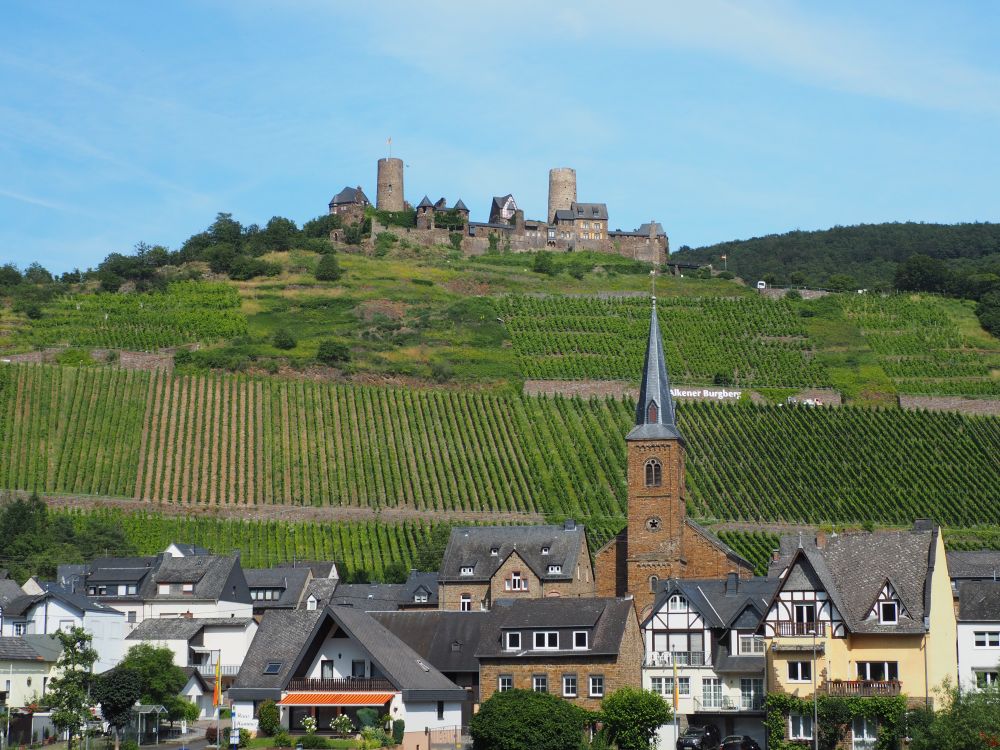
Also, if I’ve counted correctly, we passed through ten locks in each direction on the Moselle River, some during the day and some overnight. There’s something fascinating about locks.
How accessible is a VIVA cruise ship?
I’ve only seen the VIVA Moments, so I can’t vouch for any of the others. This ship has an elevator, but I didn’t see a way for a person in a wheelchair to get to the sundeck on the roof. People who are mobility impaired can reach all the rooms inside. I’d suggest, though, that you book a suite rather than a standard cabin if you’re dealing with a wheelchair or walker.
In most port stops the gangway is a gentle slope. However, the villages and towns we visited have mostly cobbled streets, narrow sidewalks, and often require some stair-climbing to see anything. There were some guests with walkers or canes who seemed to be able to do a bit of sightseeing or join an excursion, but if you are in a wheelchair you’d probably need someone to help you here and there.
What is the Moselle Fairytale itinerary like?
For each of the stops on this week-long itinerary, one excursion was available. I only took one of them, but heard good things about others. What struck me about all of them is that the prices are surprisingly good, compared to what ocean cruise excursions cost. I suppose that’s because less transportation is included, since river cruise ships park right in the center of town. The excursion I took was free for me but normally would have been only $18.
Many of the stops are only a half-day long, so you’ll have to let go of the idea that you will see all the sights in any of the places you visit. It’s just about getting a taste of each place, and perhaps choosing which are worth returning to later. On the other hand, the ship mostly stops in small villages and towns, places that don’t take very long to explore.
Düsseldorf
This trip starts and ends in Düsseldorf, and while those who arrived in taxis or buses had trouble reaching the boat – it was a Sunday and a festival day – I had no trouble at all walking the two blocks or so from the U-bahn metro station, which was just four stops from the main train station.
We left Düsseldorf in the afternoon, traveling overnight for our arrival in the morning in Koblenz.
If you’re planning to stay an extra night or two before or after the cruise, use the map below to book accommodations. Zoom in to see the city center options:
Koblenz
We actually passed through Koblenz three times. The first was this half-day stop. Then we passed it again twice in the boat, so we were able to see the riverside sights from the water as well.
On this stop some passengers took an excursion that involved a tour and some wine tasting, while others headed for the cable car across the river to the massive Ehrenbreitstein fortress. I set out on my own to see the old town and the cathedral. Then I walked to the famous Deutsches Eck, or “German Corner” with its massive statue of Kaizer Wilhelm I that we would see twice more from the river. This is the corner where the Moselle River flows into the Rhine.
We left Koblenz at 13:00, turning onto the Moselle, and arrived at our next stop at 3:30 in the morning.
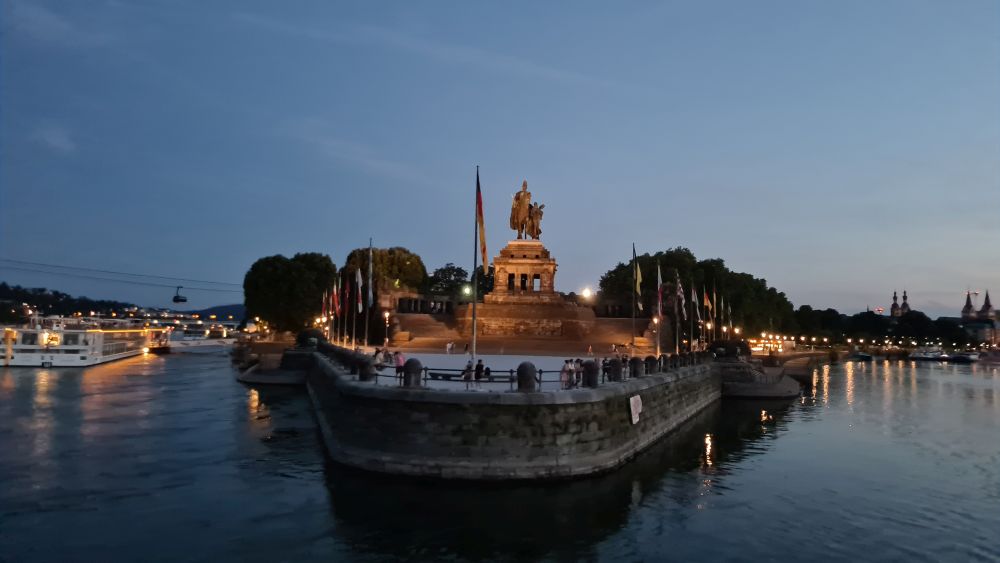
Traben-Trarbach/Bernkastel
We stayed longer in Traben-Trarbach than normal. The original itinerary had us spending a half-day here, then moving on to Bernkastel for a late-afternoon visit. For some reason a pier wasn’t available in Bernkastel so the cruise director lined up a shuttle bus to take passengers to Bernkastel in the afternoon if they wished. Some of them took a wine tour excursion that involved riding in vintage VW-buses. I heard it was great fun.
Instead, I took this opportunity to take one of the ship’s bicycles. They have about 12, I’d guess, that are free for passengers to borrow. I cycled around Traben on one side of the river and Trarbach on the other, then cycled just a few kilometers along the river to the pretty little village of Wolf.
Bicycling is easy along the river, where there is a dedicated cycle path along the road on both sides. However, the towns and villages are hilly, so be prepared, if you intend to leave the riverside.
Trier
We had the whole day in Trier, which is good because there’s a lot to see. Trier is a small city that is well known for its Porta Nigra, a Roman-era city gate that is still intact. It has several other Roman ruins as well, and many of the passengers joined a guided tour excursion of these sites. However, I’d seen all of them on a previous trip.
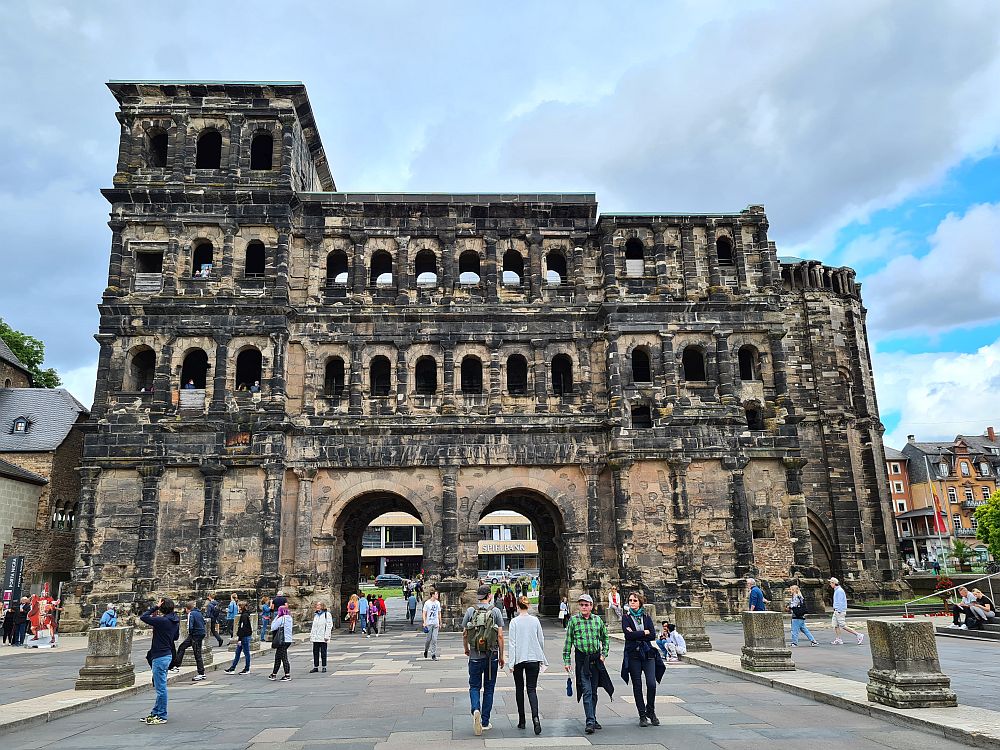
So again, I set off on my own, deciding to take in a couple of museums instead of the well-known sites. First I visited the Karl Marx House. It’s where he was born, though he didn’t stay there long. As museums go, it was rather text-heavy, but well-presented, and I appreciated their nuanced take on the impacts of Marx’s writings on history.
Next was the Landesmuseum. I’d been there before, but hadn’t had enough time to see its Roman collection well, or any of the rest of the museum. It has some amazing pieces, particularly the Roman-era mosaics.
And after that I visited the Dom Museum, which has some marvelous mosaics excavated from under the Dom Cathedral.
Trier is a place where single day might be frustrating. On my earlier visit, we took a day and a half and I still felt like two full days would have been better. Just be prepared not to see everything. See the Porta Nigra, the Dom Cathedral, the Church of Our Lady right next to the Dom, and the Landesmuseum for its mosaics.
Cochem
After turning around and cruising all night back down the Moselle, we arrived in Cochem next. We had passed it during the night on our way up the Moselle a couple of nights earlier.
This was a longer stop, and I took the excursion to see Reichsburg Castle, which looms over the town of Cochem. This involved a drive through twisty and steep streets in a van, then a short tour of the castle. I was a bit disappointed in the tour. It was only about 40 minutes long and only included a small portion of the castle. In any case, the castle is of a kind I’ve visited before: a 19th-century expression of what a medieval castle should look like, much like Castle De Haar here in the Netherlands or Balmoral Castle in Scotland.
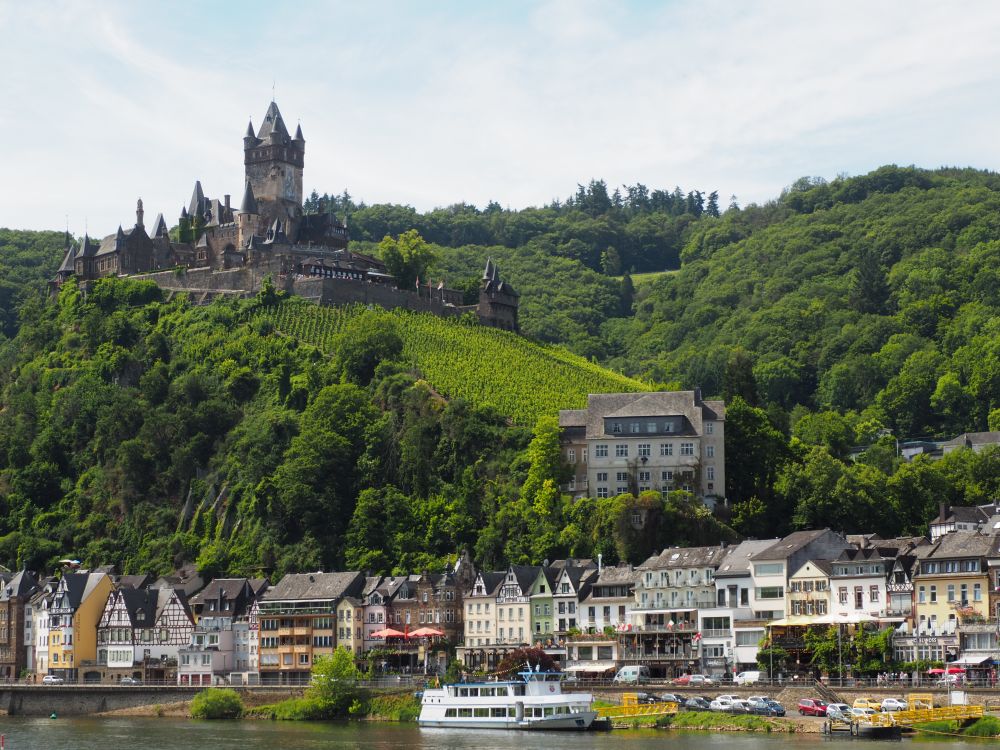
Rather than taking the van back down, I decided to walk, and enjoyed exploring the town, spotting half-timbered buildings. When it started to rain, I ducked into a charming little museum: the Barockvilla Böcking, “where already Goethe was a guest.” This restored house illustrates how a wealthy upper-class family lived in the 18th-19th-centuries. The rooms are furnished to the period.
The top two floors hold exhibits that are more like one of those typical small-town museums I enjoy. It has various collections of things that may or may not be connected to the town’s history. It has archeological finds spanning centuries of local history, but also things like a stamp collection, a coin collection, and a collection of fossils.
Leaving Cochem, we turned from the Moselle onto the Rhine at the German Corner in Koblenz and headed south.
Rüdesheim
This is a pretty little village whose main attraction is the massive Niederwald Monument on the mountain above it, which commemorates Germany’s victory in the Franco-Prussian War (1870-71). I didn’t have any interest in the monument, but the cable car up there was definitely worth the ride. The cars are tiny, only holding two people facing each other, and have open sides.
The short ride up the hill offers lovely views of the vineyards below, the town itself, and a big section of the Rhine River valley.
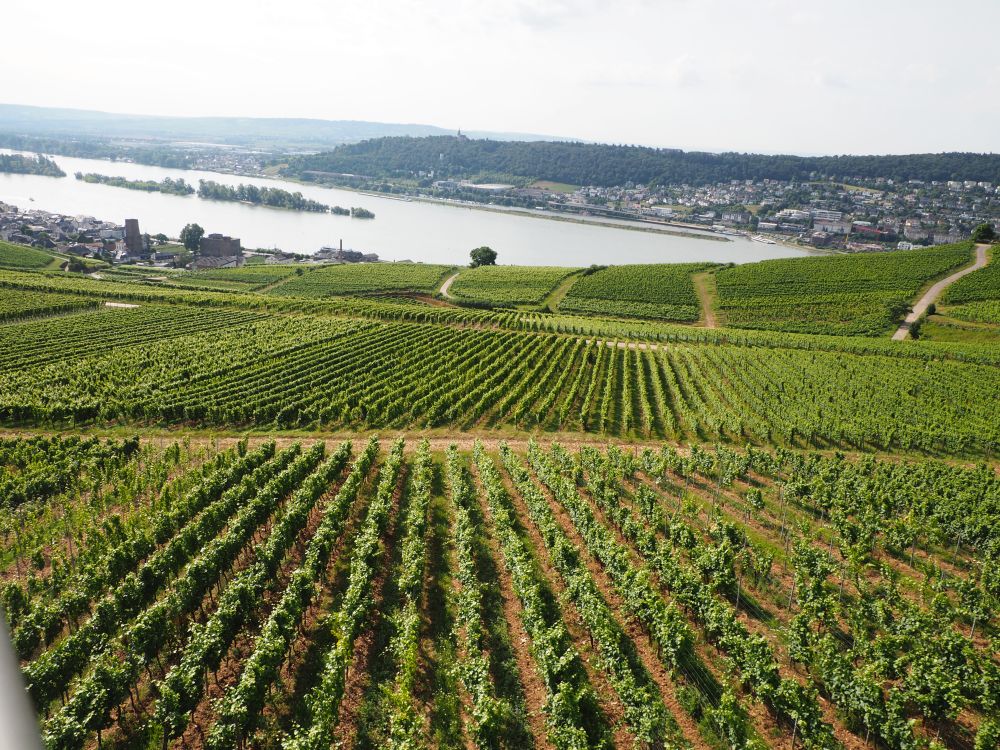
Leaving Rüdesheim at 14:00, we entered what I consider the most interesting part of the cruise: the Upper Middle Rhine Valley. I’d been there on a road trip before, visiting many of the castles that perch on so many of the hills above the river, but I was excited to see them from the water.
This afternoon did not disappoint. The villages we passed along the river were picturesque, and it didn’t take much effort to spot the castles looming above. Most of the passengers sat on the sundeck under the shade on this hot day. I spent the afternoon trying to stay in the shade but popping out to the rail very often to snap pictures.
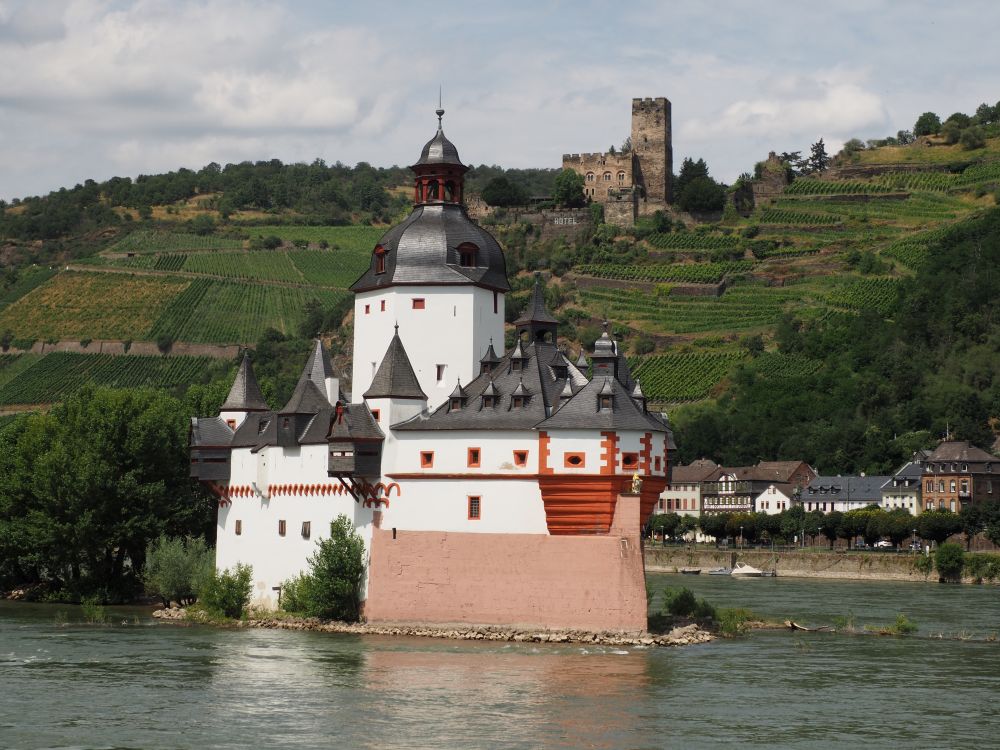
Our destination that day was Linz am Rhein, passing through Koblenz again, and that night was the only night we stayed moored in one place. So we could go walk in the slightly cooler evening air to get a sense of the town, and return again in the morning for better pictures.
Linz am Rhein and Bonn
Linz am Rhein is yet another pretty little town with lots of half-timbered houses. The excursion here involved a simple walking tour around the town, so I just did it on my own.
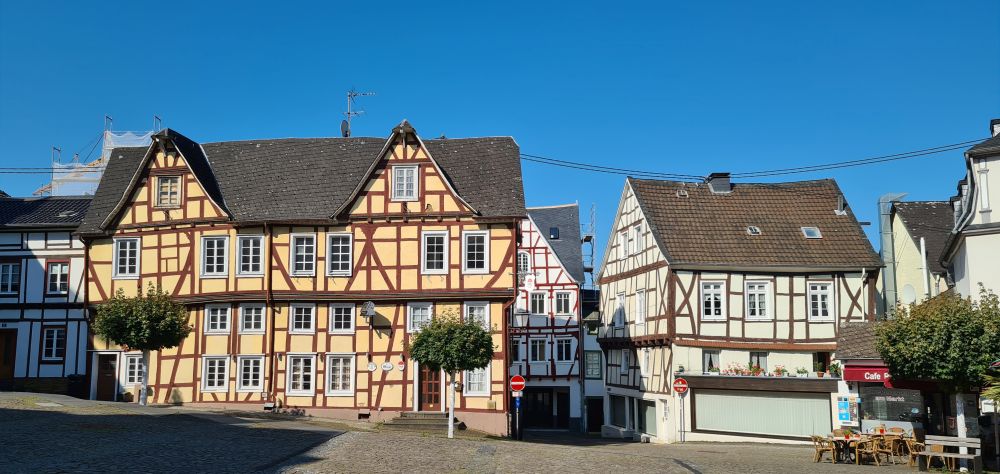
In the afternoon we cruised briefly as far as Bonn, the capital of the former West Germany. It’s a much bigger city and the day was very hot. After my morning’s walk around Linz, I didn’t feel like doing more so retreated to my cabin.
We left Bonn late at night and by early morning, we were back at our starting point in Düsseldorf.
What is VIVA doing about sustainability?
I can’t say that river cruising is guilt-free as far as sustainability is concerned. And I can’t seem to find any actual calculations of things like CO2 emissions of river cruises as compared to other forms of transportation. However, I think it’s safe to say that a river cruise is less polluting than an ocean cruise. What I don’t know is how much less.
VIVA’s website says that it uses GTL fuel, which stands for gas-to-liquid. It’s made from natural gas and is used as a substitute for diesel fuel. Apparently it burns cleaner than diesel. How big of a difference this makes? I don’t know. VIVA also switches off the engines to use shore power when possible – I did see that at some ports.
VIVA’s two newest ships, the VIVA One and the VIVA Two, have solar panels which reduce their fuel consumption.
On board, VIVA takes the measures that many companies are applying nowadays. They provide each passenger with a water bottle and a place to refill it. They mostly avoid the use of plastic and disposables, using paper straws, for instance, and bowls of sugar rather than packets. The sheets and towels aren’t changed every day. A keycard opens the cabin doors, and the air conditioning and lights won’t turn on until the keycard is in a slot by the door.
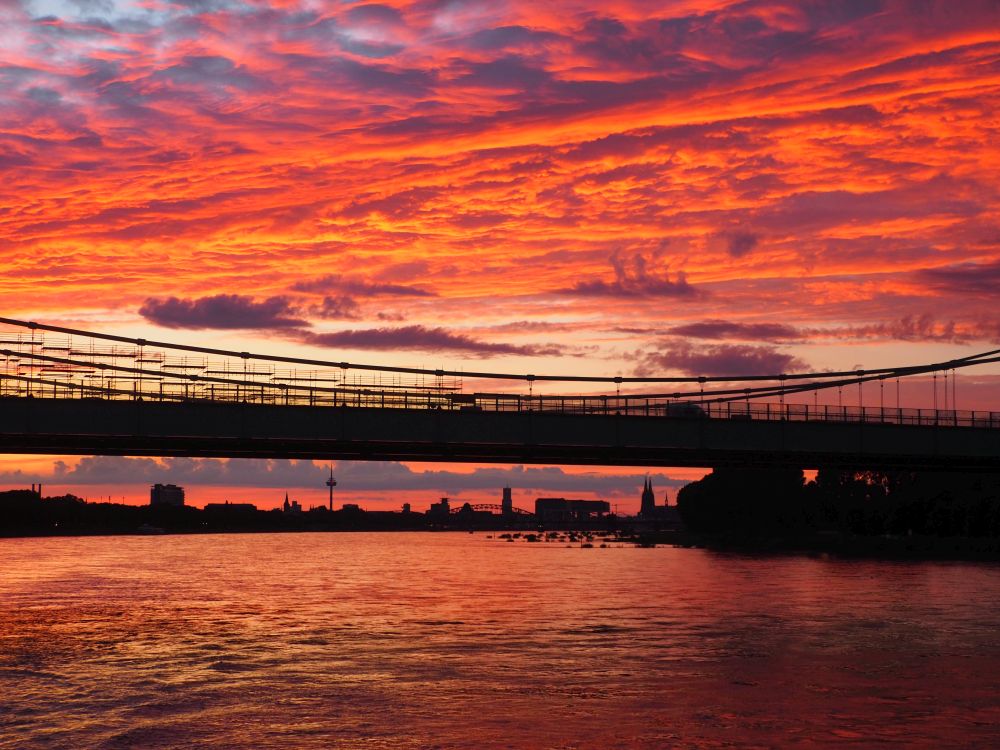
What I liked about the cruise
- I loved the scenic route of this “Moselle Fairytale” cruise, especially the final day on the Rhine.
- I loved having so much free time, and a pleasant roof deck to relax on and watch the scenery go by.
- The ship is very quiet, as is the clientele.
- The ship is well-designed, clean, and perfectly maintained.
- The wifi (included) is remarkably fast.
- The room was very well-appointed in every way, and I especially liked being able to open the sliders so wide. The bathroom is elegantly-designed with a decent-sized shower stall.
- Service was great, with a friendly staff who go out of their way to make sure the guests are happy.
- The food was very good and often excellent.
- You can go to the dining room to eat at any moment during the set hours that they’re open. No assigned tables or mealtimes.
- Each day’s port stop is central to a town, which means it only takes a few steps off the ship to start the day’s sightseeing.
- It is all-inclusive, which actually means all-inclusive, except for excursions, which are reasonably priced. The drinks menu has plenty of choices. I found that I didn’t really need to use it. I could just name a drink I wanted and the bartender would make it.
- It’s a little thing, but it was great to have a mini-fridge I could actually use. So often hotels will stock a mini-fridge but then charge outrageous prices.
- It was good to be able to borrow a bike with no fuss or expense.
Until the end of 2024, you can use the code RACHEL5 to get a 5% discount when you book a Viva Cruise!
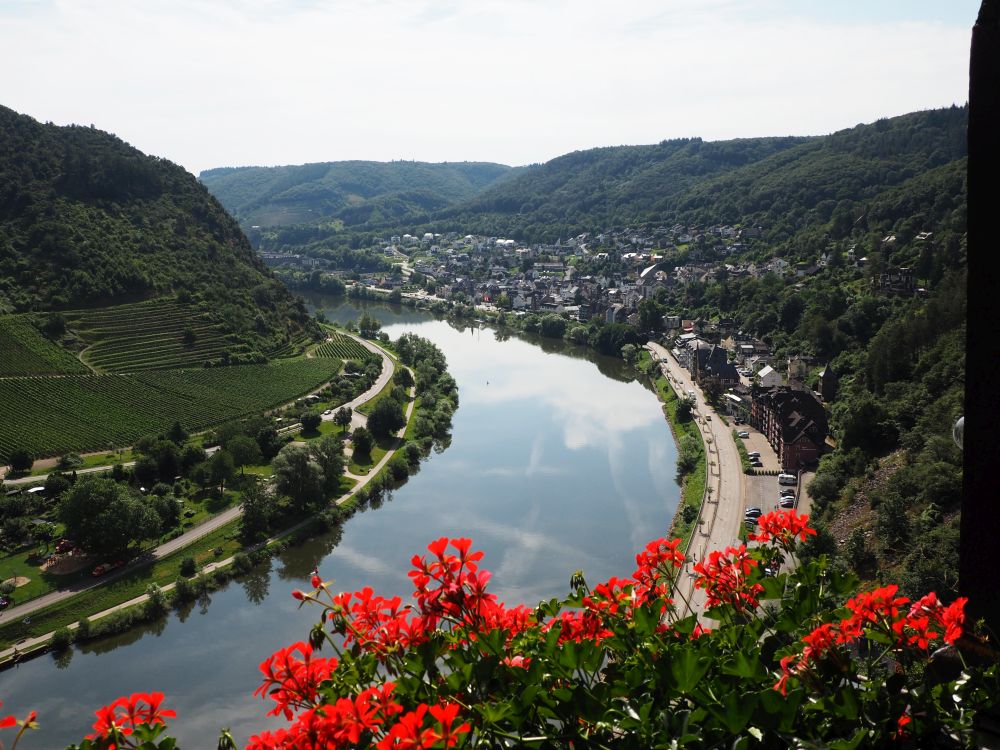
What I didn’t like about the cruise
- It was just a matter of luck, but I would have liked a bigger range of fellow passengers: people from more different countries and a wider age range. There’s not much you can do about this except bring your own social group along. A cruise like this would be great with a group of friends.
- Again, it wasn’t VIVA’s fault, but there were a lot of smokers on this cruise. They were only allowed to smoke outside on the deck, so when I was outside I got the occasional lungful if I wasn’t paying attention to where I sat or stood. I gather that on some of their ships there are smaller smoking zones on the deck. That seems better.
- I kept getting a shock from the railings on the upper deck. It would be good if, when they renovate the ship eventually, they add a wooden rail on top of the metal.
- I wish the “pool” was a jacuzzi: significantly hotter and with jets.
Last thoughts
This was my first river cruise, and I enjoyed it very much. Unlike a sea cruise, you travel close to the land, so there’s always something to see. The ship is much smaller and quieter than a sea cruise, and less polluting besides. It doesn’t have that frenetic quality of constant activities and entertainment that sea cruises offer. To some, that might make a sea cruise more attractive, but not to me.
Looking at VIVA cruises in particular, since it was my first river cruise, I can’t really compare it to other companies. But I can say that I would recommend it: it’s well-run, with comfortable cabins and great service, and they offer a range of excellent routes.
This particular route is beautiful. There’s something really calming about the sight of those neat rows of grapevines covering the hillsides along the Moselle and the Rhine. Take a look at the pictures accompanying this article and you’ll get a sense of how pretty this region is.
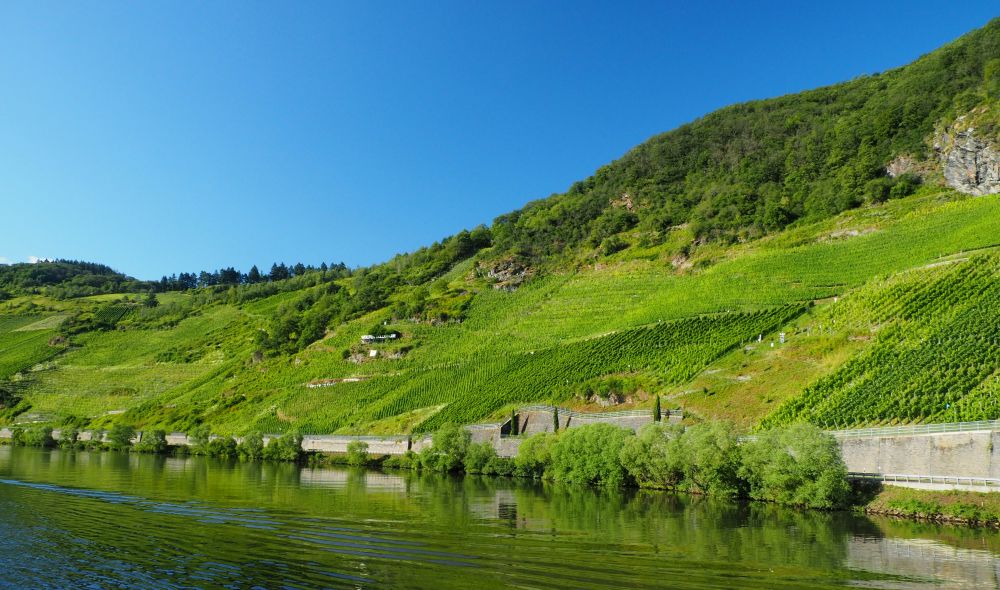
VIVA has plenty of other routes in Germany, but also on the Baltic Sea, the Danube, the Rhone and Seine in France, and the Douro in Portugal.
Whenever we passed ships from other companies – Tauck, Viking, Riviera and others – it seemed to me that, at least looking at overall design, our ship outshone most of them, if for no other reason than the huge windows on the rooms.
I’d recommend river cruising if you want to take it easy: just lounge and watch the scenery, drink in hand. Then, at the port stops, you join an excursion or just take a walk. It’s all wonderfully easy. Without the barrage of entertainment, activity, and event offerings you get on an ocean-going cruise ship, you can really relax.
Winter trips on a river cruise?
VIVA has one thing that particularly stands out from other river cruise lines. Generally, European river cruises stop operating after Christmas or after New Year’s. VIVA goes all year. In January, February and March they offer shorter trips of four or five nights. These either focus specifically on the bigger cities or are themed: wellness or crime.
- The city trips go to the Netherlands, Belgium or Germany, and stop only in big cities.
- The wellness trips are on the Rhine. They include a wellness coach, lectures on health, a wellness menu, daily yoga and qi gong, and a 30-minute massage.
- The Crime Cruise Passau travels the Danube. Crime writers come on board to talk to passengers.
I can imagine that these off-season cruises would mean seeing the cities in a very different light. They’d have very few tourists, if any, crowding the streets. It would be colder, but that also might mean pretty, snow-covered hills, if you’re lucky.
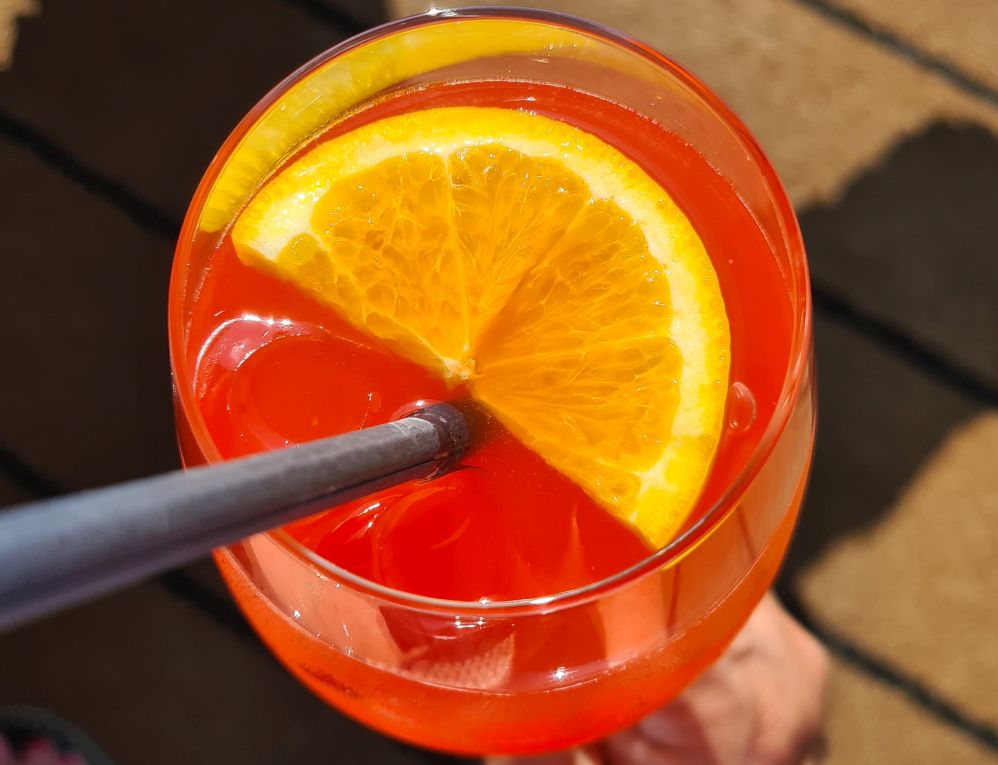
My advice for taking the “Moselle Fairytale” cruise
- Travel with friends or family.
- Book a cabin on the right/starboard side of the ship. It gets you the best views across the river for the majority of the route. Only in the last couple of days will your room face the near riverbank.
- Choose a French balcony room is you can afford it. You won’t regret it.
- Leave an extra day or two at the beginning and/or end to explore Düsseldorf.
- When you first get on the ship, go ahead and book one or two dinners at the bistro. They book up fast.
- Ask for local wines. The house wines aren’t always local, but they have local wines in stock. You just need to express that preference.
- The outlets are European two-prong outlets, except for one UK-style three-pronged outlet above the desk. I don’t know if this is true in every room, but if you’re from the US, you’ll need an adapter.
- Bring a book, a sunhat, sunglasses, and sun lotion.
So tell me: is this something you would consider doing?
My travel recommendations
Planning travel
- Skyscanner is where I always start my flight searches.
- Booking.com is the company I use most for finding accommodations. If you prefer, Expedia offers more or less the same.
- Discover Cars offers an easy way to compare prices from all of the major car-rental companies in one place.
- Use Viator or GetYourGuide to find walking tours, day tours, airport pickups, city cards, tickets and whatever else you need at your destination.
- Bookmundi is great when you’re looking for a longer tour of a few days to a few weeks, private or with a group, pretty much anywhere in the world. Lots of different tour companies list their tours here, so you can comparison shop.
- GetTransfer is the place to book your airport-to-hotel transfers (and vice-versa). It’s so reassuring to have this all set up and paid for ahead of time, rather than having to make decisions after a long, tiring flight!
- Buy a GoCity Pass when you’re planning to do a lot of sightseeing on a city trip. It can save you a lot on admissions to museums and other attractions in big cities like New York and Amsterdam.
Other travel-related items
- It’s really awkward to have to rely on WIFI when you travel overseas. I’ve tried several e-sim cards, and GigSky’s e-sim was the one that was easiest to activate and use. You buy it through their app and activate it when you need it. Use the code RACHEL10 to get a 10% discount!
- Another option I just recently tried for the first time is a portable wifi modem by WifiCandy. It supports up to 8 devices and you just carry it along in your pocket or bag! If you’re traveling with a family or group, it might end up cheaper to use than an e-sim. Use the code RACHELSRUMINATIONS for a 10% discount.
- I’m a fan of SCOTTeVEST’s jackets and vests because when I wear one, I don’t have to carry a handbag. I feel like all my stuff is safer when I travel because it’s in inside pockets close to my body.
- I use ExpressVPN on my phone and laptop when I travel. It keeps me safe from hackers when I use public or hotel wifi.



Thank you for this article. When was your cruise? I don’t see the date anywhere. Was there a line for drinks at any time?
It was last July 2024. There were never lines for drinks but that’s because everyone ordered drinks from a waiter. So you might have to wait a bit to get the drink, but it was never long. Once I just went up to the bar and asked for a drink and got it pretty immediately, but it looked like the norm was to order them from a waiter.